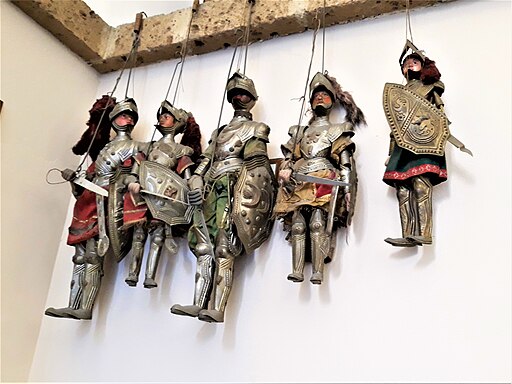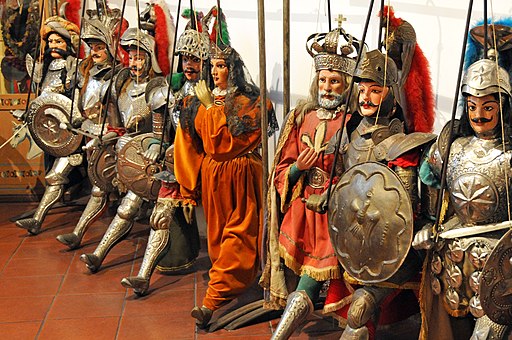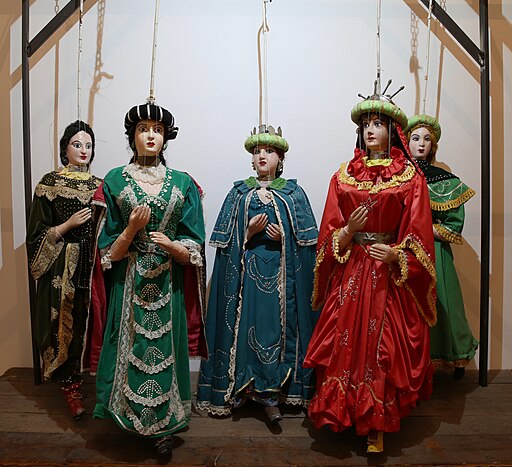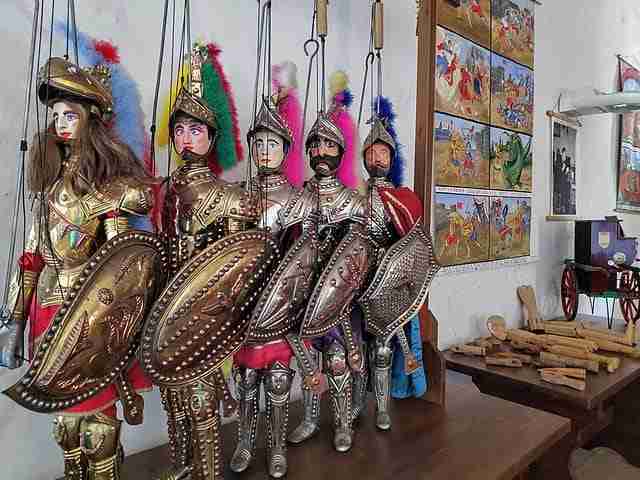Opera dei pupi
Sicilian Puppet Theatre
The Opera dei Pupi is the puppet theatre (called “pupi” from the Latin pupus, which means child) typical of the Sicilian tradition. The Opera dei Pupi was in fact born in Sicily, Italy, at the beginning of the nineteenth century. And from the very beginning had a great success among the working classes. The shows staged in episodes, in narrative cycles that lasted many months, in venues located in poor neighbourhoods.
 Photo by Tailduck, CC BY-SA 4.0, via Wikimedia Commons
Photo by Tailduck, CC BY-SA 4.0, via Wikimedia Commons
Originally it was a street theatre, typical of the tradition of storytellers, called “pupari” because their task. In addition to playing the role of screenwriters, directors and actors, was also to build the “pupi”. The stories told, whose dialogues are almost always improvised by the puppeteers, are based – today as in the past – above all on medieval chivalry literature, on Italian and French epics, on the lives of saints and on the stories of brigands.
The backdrops, called “scenes”, are carefully painted and depict palaces, castles, cities, squares, camps, gardens, etc… In addition, the figurative appearance of the different environments evokes the theatrical fashion of the nineteenth century.
Opera dei Pupi – a Cultural Heritage
UNESCO listed in 2008 (originally in 2001), the Sicilian Opera dei Pupi as Intangible Cultural Heritage of Humanity. Certainly, one of the most significant examples of the historical memory and cultural identity of Sicily.
The Sicilian Opera dei Pupi distinguishes itself from other forms of puppet theatre in Italy and abroad for its repertoire, mechanics, figurative style, stage organization. And also the type of acting. The puppets of the eighteenth century were animated from above. By a thin metal rod connected to the head through a joint and by means of several wires. Which allowed the movements of the arms and legs.
In Sicily, in the first half of the nineteenth century, effective technical devices were devised that transformed the puppets into “pupi”. Ensuring that the metal rod for the movement of the head has no connection to it through a joint. But it crossed the puppet from the inside. And replaced the wire for the animation of the right arm with the sturdy metal rod. Characteristic of the Sicilian puppet.
These new technical expedients made it possible to give the animated figures more rapid, direct and decisive movements. And therefore particularly effective for imitating duels and fights on the scene, widely present in chivalric stories.
On and Off Stage
Even today the theatre managers move the puppets, make them talk, sometimes they build them, paint the scenes for them. Often the epic shows include the masks of the Sicilian theatrical tradition. Comic heroes and representatives of the people who accompany the protagonists as relatives and servants. According to a well-established tradition in the European puppet theatre.
 Photo by Daniele Pugliesi, CC BY-SA 3.0, via Wikimedia Commons
Photo by Daniele Pugliesi, CC BY-SA 3.0, via Wikimedia Commons
We pass from tragedy to comedy. From farce to drama with notable cases of satire which, through the medieval metaphor, attacked the society of the time. Above all, in the Opera dei Pupi there was the transmission of noble behavior. Such as the codes of chivalry, the sense of honour, the struggle for justice and faith.
Theatre companies would stop in one place. And perform daily in one or more narrative cycles that could last several months or years. When the audience lost interest, theatre companies needed to move to a new place. To announce and advertise the show of the day. The “pupari” displayed, for instance, large signs painted in bright colours outside the theatres.
The audience sat on crude wooden benches or, sometimes, on boxes. The spectators, almost exclusively adults and boys, followed the stories with great emotional participation. Identifying themselves with the positive heroes and raging on the evil ones. Sometimes to the point of destroying the “pupo” representing the hated character.
The puppets
Even today, these shows are managed on a family level and the puppets are built and painted with traditional methods. The craftsmanship of a puppet has in fact remained identical to that applied by the first builders. The structure of the puppet is in wood. Richly decorated with bright colours and covered with an armour and a cloak that characterize the character. And also distinguish him from the others. Normally the head and the skeleton of the “pupo” are in wood. The skeleton has a torso. From which the legs and the arms, which can move in all directions, articulate.
 Photo by Lucarelli, CC BY-SA 3.0, via Wikimedia Commons
Photo by Lucarelli, CC BY-SA 3.0, via Wikimedia Commons
To move, Sicilian puppets have two strong irons and two or three wires connected to the limbs. The iron to which the control wires are fixed crosses the head and joins the torso. Its hook-shaped top allows you to hang the “pupo” and, thanks to its inclination, the puppet performs the different movements.
Spectators recognize the characters by the expressiveness of their faces. The shape of the copper or brass armour and the emblem they wear on the armour and shield. From the figurative point of view, it is generally possible to distinguish the characters with armour and without it. The armed puppets division is between Christians and Saracens. Christian warriors have kind faces and feature emblems on their helmet, breastplate and shield. The Saracens, on the other hand, have more marked facial features; they often wear trousers and turban. Finally, among Christians, traitors are recognized by their shorter stature and the black colour of their robes.
Opera dei Pupi: One art, two different styles
The main Sicilian puppet schools are those of Palermo and Catania. In fact, there are two distinct traditions of the Opera dei Pupi in Sicily. The Palermo one, located in western Sicily, in the provinces of Agrigento, Palermo and Trapani. And also the Catania one, which characterizes eastern Sicily, the provinces of Messina, Catania and Syracuse. The most evident difference is in the joints. Light and articulated those of the Palermo tradition (however difficult to manoeuvre). Heavier and with fixed limbs those of Catania (much easier to manoeuvre).
They differ not only for the mechanics, but also for the figuration and for some particular subject of the repertoire. In the Palermo puppet, then, the torso and legs are made of solid wood. While in the Catania area the wooden skeleton is padded.
Palermo School
In the Palermitan style of the Opera dei Pupi, the puppets are about 90 cm tall. And weigh between 5 and 10 kilos. The legs have free forward movement, but limited backward movement. They have articulated knees and can draw the sword thanks to a thread running through the right hand.
 Photo by Ettorre (gregorio) mail: ettorre(at)gmail(dot)com]], CC BY-SA 4.0, via Wikimedia Commons
Photo by Ettorre (gregorio) mail: ettorre(at)gmail(dot)com]], CC BY-SA 4.0, via Wikimedia Commons
In Palermo the puppets are maneuverer from the sides of the stage. Behind the scenes, where the puppeteers operate with outstretched arms on the same plane on which the puppets move. The master, in addition to manoeuvring the puppets, gives directions to his helpers, improvises the dialogues, performs all the recited parts (including the female ones) and creates sound and lighting effects.
Since the Palermo puppets are smaller than those of Catania, the theater hall is rarely able to accommodate more than one hundred spectators. The stage is usually deeper than wide, as a result of the puppeteers’ maneuvering position.
 Photo by Paolo Monti, CC BY-SA 4.0, via Wikimedia Commons
Photo by Paolo Monti, CC BY-SA 4.0, via Wikimedia Commons
In the past the show was accompanied musically by one or more violins. But already replaced at the end of the nineteenth century by the cylindrical piano.
Most important, currently there are nine puppet companies of the Palermo school. Who are depositories of the oral and intangible cultural heritage of the puppet opera. As well as material goods (puppets, signs, scenes, tools, etc.), historical and modern in use for the realization of the shows.
Catania School
The puppets of the Catania tradition, on the other hand, have a padded wooden skeleton. And they are taller and heavier than those of Palermo; in fact, they reach a height of about 110-130 cm and a weight of about 30 kilos. If they are warriors, they almost always have the sword in their hand. Their legs are rigid, with no joint at the knee, therefore they cannot kneel. This however allows the considerable weight of the puppets to be unloaded onto the stage. Thus facilitating the movement of the puppets.
 Photo by Dennis Jarvis from Halifax, Canada, CC BY-SA 2.0, via Wikimedia Commons
Photo by Dennis Jarvis from Halifax, Canada, CC BY-SA 2.0, via Wikimedia Commons
The Catania puppets are moved by the puppeteers, who are on a raised bridge positioned behind the backdrop. Further, the size and weight of the puppets and their manoeuvring system determine the shallow depth of the stage to the advantage of a greater width of the scene. The voice is given to the puppets from behind the scenes, improvising the dramatic dialogues or reading the script.
Since the Catania puppets are larger than those of the Palermo area, the theatrical halls can also accommodate two hundred or more spectators. The show was traditionally accompanied by a small plectrum orchestra. To which an accordion was often added and, in particular evenings, some wind musical instruments.
 Photo by Paolino.uccello, CC BY-SA 4.0, via Wikimedia Commons
Photo by Paolino.uccello, CC BY-SA 4.0, via Wikimedia Commons
In Catania the backdrops are painted in tempera on rectangular sheets of paper. And depict the most important scene of the evening performance.
Moreover, in Catania, in addition to the subjects traditionally represented throughout Sicily, the traditional repertoire also included other stories. In fact, a chivalrous repertoire much wider than that of Palermo has established itself here and in many ways different. With a more tragic, sentimental and realistic theatrical conception and spectacle.
There are currently five families of puppeteers in eastern Sicily that carry on this historic tradition.
The Preservation of Opera dei Pupi
Today the puppet theatre is a purely niche show. Reserved for a few amateurs, schools, tourists, or the protagonist of special theatrical reviews.
The current review of the Sicilian Opera dei Pupi, held every year in Sicily, aims to promote the process of transmission and safeguarding of the intangible cultural heritage of which the “pupari” (puppeteers) are custodians, promoting, disseminating and enhancing the Opera itself.
Resume
The Opera dei Pupi is a type of puppet theater (“pupi”). Whose protagonists are the characters of medieval and Renaissance novels and epics, particularly Italian and French. The Opera dei Pupi affirms itself above all in Sicily between the second half of the nineteenth century. And the first half of the twentieth century. The puppeteer took care of the show, the scripts, the puppets. And with a particular tone of voice he knew how to give suggestions and pathos to the epic scenes represented, bewitching the audience with intriguing stories of spells, betrayals, deceptions, loves, duels and battles. In 2008 (originally in 2001) UNESCO registered the Opera dei Pupi as Intangible Cultural Heritage of Humanity.
